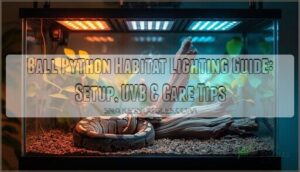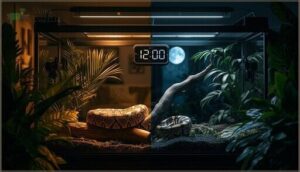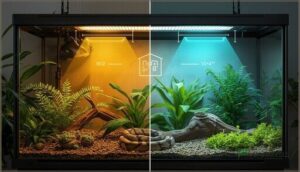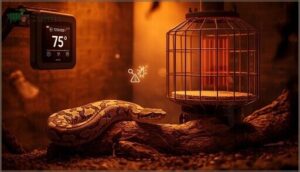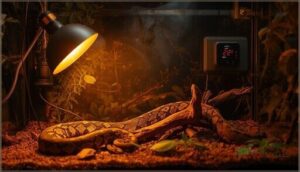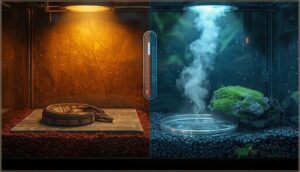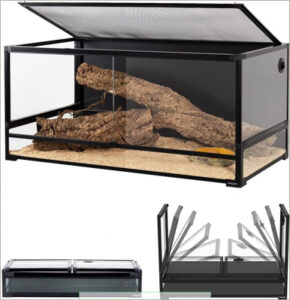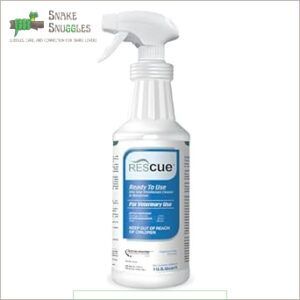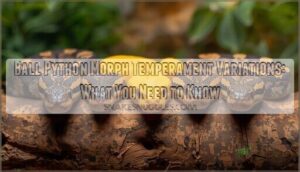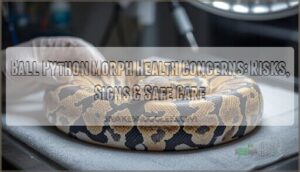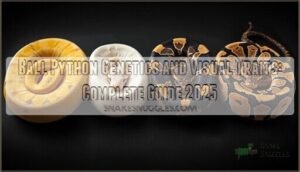This site is supported by our readers. We may earn a commission, at no cost to you, if you purchase through links.
Your ball python doesn’t need a tanning bed, but it does need the right light exposure to thrive. In the wild, these snakes experience predictable dawn-to-dusk cycles that regulate everything from their appetite to their stress levels.
When you replicate those natural rhythms in captivity, you’re not just setting up bulbs—you’re creating an environment that sustains their circadian biology and encourages healthy behavior patterns.
Getting the lighting wrong can mean sluggish feeding responses and chronic stress, while a proper setup with the right UVB intensity, heat sources, and photoperiod timing transforms your enclosure into a space where your python can truly flourish.
Table Of Contents
Key Takeaways
- Ball pythons require a consistent 12-hour day/night cycle to maintain their circadian rhythm, with lighting that simulates dawn and dusk transitions to encourage natural crepuscular activity and reduce stress.
- Low-intensity UVB lighting (UVI 1.1-3.0 in basking zones) supports vitamin D3 synthesis and overall health, with T5 HO linear fluorescent bulbs positioned 15-18 inches above basking areas being the most effective option.
- Proper lighting setup must integrate with heating elements to create a thermal gradient of 88-92°F in basking areas and 76-80°F in cooler zones, while maintaining 60-80% humidity through strategic placement and substrate selection.
- UVB bulbs should be replaced every 6-12 months regardless of visible brightness because their output degrades over time, with signs like reduced basking behavior and lethargy indicating the need for replacement.
Ball Python Lighting Needs Explained
Getting your ball python’s lighting right isn’t just about flipping a switch—it’s about recreating the rhythm of their natural world. These snakes have specific needs tied to their African origins, and understanding how light affects their behavior will help you create a healthier home.
Let’s break down what your ball python actually needs in terms of lighting and why it matters.
Natural Day/Night Cycles for Ball Pythons
Ball pythons need a consistent 12-hour day/night cycle to support their natural circadian rhythm. In the wild, they experience minimal seasonal variation near the equator, so maintaining a steady photoperiod benefits their overall health.
During daytime hours, your snake will remain hidden, becoming active at dusk and dawn. Even albinos basking less frequently still require this structure. Use a timer for consistency, and provide nighttime heat without light.
With proper care, they can reach their average adult size of 4–5 feet.
Importance of Simulating Crepuscular Activity
Lighting that mirrors dawn and dusk periods encourages your ball python’s natural crepuscular behavior. When you simulate these transitions, your snake will bask, explore, and regulate its body temperature at the right times. This crepuscular light cycle aids circadian rhythm, promotes vitamin D3 synthesis through measured UVB exposure, and reduces stress. Without proper dawn/dusk simulation, basking behavior decreases, which carries welfare implications for long-term health.
Simulating dawn and dusk transitions encourages your ball python’s natural activity patterns, supporting healthy basking behavior and reducing long-term stress
Ball pythons are native to sub-Saharan Africa, inhabiting savannas, grasslands, and forest edges.
Understanding UVB and Full Spectrum Lighting
UVB and full spectrum lighting serve distinct roles in your ball python’s habitat. UVB Benefits include supporting vitamin D3 production, while full spectrum lighting enhances color perception and visual health.
Lamp Efficacy varies considerably—T5 HO fluorescent tubes provide reliable coverage, whereas coil bulbs fall short.
Deficiency Signs like lethargy and poor appetite indicate inadequate exposure. Aim for UVI Levels between 1.1 and 3.0 in basking zones for best reptile lighting.
Choosing The Right Lighting Equipment
Setting up proper lighting for your ball python doesn’t have to be complicated, but choosing the right equipment makes all the difference. You’ll need to think about whether UVB is part of your setup, what fixtures work best for your enclosure, and how to maintain everything over time.
Let’s break down the key components that’ll keep your snake healthy and your habitat running smoothly.
Best Light Bulbs for Ball Python Habitats
You’ll want T5 HO linear fluorescent UVB bulbs at 22 inches for reliable low-intensity UVB exposure in your ball python’s enclosure. Pair these with 75-watt halogen flood bulbs for basking heat, providing essential IR-A radiation for thermoregulation. Add 6000-7000K full spectrum LED plant lights to mimic natural daylight rhythms.
Trusted brands like Arcadia and Zoo Med deliver consistent performance in reptile lighting and heating equipment.
UVB Vs. Non-UVB Lighting Options
Deciding between UVB and non-UVB lighting for your ball python comes down to weighing health benefits against practical concerns. UVB aids D3 synthesis and bolsters behavioral impacts like improved immune function, but overexposure risks exist without proper gradient creation.
Non-UVB setups work fine for survival and win on cost analysis, though they miss potential wellness advantages. Most keepers find low-level UVB worth the investment.
Proper Placement and Fixture Selection
Before you install anything, understand that proper UVB distance makes all the difference. Position your T5 HO fixture—whether Arcadia or another trusted brand—15 to 18 inches above the basking platform to achieve the ideal UV Index.
Place basking lighting at one enclosure end for thermal gradients. Reflective fixtures boost heat coverage by 35%, while secure mounting at least six inches from any accessible surface prevents burns.
When to Replace Bulbs for Maximum Effectiveness
Even when your UVB bulbs look bright, their output weakens over time through natural UVB degradation. Replace T5 bulbs every 6 to 12 months—brand variations affect timing—to prevent old bulb effects like lethargy and poor calcium absorption.
Track your bulb replacement dates by marking installation times. If you’re monitoring behavior and notice reduced basking, it’s time for fresh UVB lighting for ball pythons.
Setting Up Lighting in Your Enclosure
Once you’ve chosen your lighting equipment, the next step is putting it all together in a way that keeps your ball python safe and comfortable. Proper setup means more than just screwing in a bulb—you’ll need to think about light cycles, placement, and how your lighting works alongside your heating elements.
Let’s walk through the key steps to get your enclosure lighting right from the start.
Creating a 12-Hour Light Cycle
Establishing a consistent 12-hour day-night cycle is essential for your ball python’s circadian rhythm and overall health. Use timer automation to eliminate guesswork—studies show 84% of keepers rely on timers for reliable lighting. Veterinary recommendations emphasize that proper UVB and reptile lighting setup reduces stress by 64% and improves feeding responses.
Key steps for creating your cycle:
- Set lights on at 6:00–8:00 AM, off at 6:00–8:00 PM
- Use automatic timers to maintain consistent schedules year-round
- Avoid seasonal simulation unless breeding—it causes feeding refusal in 27% of cases
- Choose programmable outlets for enhanced control and energy savings
- Monitor health implications like stress markers and digestive function regularly
Positioning Lights for Safe and Effective Coverage
A proper reptile lighting setup hinges on strategic placement. Position heat lamps at one end to create a heat gradient, maintaining a 6-inch minimum light distance to prevent burns.
UVB bulbs should cover half the enclosure length, mounted 10–14 inches above basking spots when mesh obstruction is present.
Secure all fixture security overhead using guards, and choose trusted reptile lighting brands like Arcadia for reliable reptile UVB output.
Preventing Burns and Overheating
Burns often happen faster than you’d expect with unregulated heat sources. Keep your snake safe by following these key safety measures:
- Use only thermostatically controlled heating equipment to prevent dangerous temperature spikes
- Monitor basking surfaces with an infrared temp gun, ensuring they stay under 104°F
- Position all heat sources with guards preventing direct contact
- Watch for health indicators like lethargy or skin discoloration signaling overheating
Integrating Lighting With Heating Elements
Once you’ve safeguarded against burns, your next move is coordinating lighting with reptile heating to support your ball python’s metabolic needs. A halogen bulb paired with a heat emitter maximizes energy efficiency while establishing proper heat gradients across your enclosure.
| Equipment Type | Primary Function |
|---|---|
| Halogen bulb + thermostat | Daytime basking heat and UVB support |
| Ceramic heat emitter | Nighttime warmth without light |
| Light timers | Automate 12-hour cycles |
| Bulb replacement schedule | Maintain consistent output every 12 months |
Regular thermostat calibration keeps your setup stable.
Maintaining Proper Temperatures and Humidity
Getting your lighting setup right is only half the battle—you also need to nail the temperature and humidity levels that keep your ball python healthy. Think of it like creating different climate zones in your enclosure, from a warm retreat to a cooler resting spot.
Let’s break down the specific measurements and tools you’ll need to maintain these critical conditions.
Establishing a Thermal Gradient
To keep your ball python healthy, you need to create a temperature gradient inside the enclosure. This thermal gradient lets your snake move between a warm basking area around 88-92°F and a cooler zone at 76-80°F for natural temperature regulation.
Use infrared thermometers and adjustable heating devices to monitor and fine-tune the gradient, ensuring a 10-15°F difference between zones.
Monitoring Basking Surface and Nighttime Temperatures
Once you’ve set up that thermal gradient, you’ll need to track it carefully with the right tools. An infrared thermometer lets you check basking surface temperature quickly—aim for 88-92°F—while digital probe thermometers continuously monitor both warm and cool zones.
At night, maintain 70-78°F using nighttime heat sources if needed. Accurate device calibration and temperature logging benefits help you avoid thermal burn risks and guarantee consistent temperature maintenance for healthy temperature regulation.
Balancing Humidity With Lighting Setup
Your lighting setup directly influences humidity levels in your Ball Python enclosure. Here’s how to maintain that 60-80% range:
- Use at least 4 inches of moisture-retentive substrate to buffer against drying effects from UVB and heat lighting types
- Position water dishes under heat lamps to boost localized evaporation
- Time misting routines heavier at night when lights are off
- Add humid hides for microclimate refuge
- Monitor humidity fluctuations with multiple hygrometers
LED lights produce less heat than halogens, reducing substrate moisture loss. Mitigation strategies like adjusting ventilation prevent both over-saturation and excessive drying in your enclosure.
Tools for Temperature and Humidity Control
Accurate monitoring starts with quality instruments. You’ll need at least two digital thermometers and two hygrometers per enclosure—one set for each thermal zone.
Proportional thermostats like Herpstat maintain temperatures within 1°C of your target, while hygrostat-controlled humidifiers automate humidity regulation.
Data logging devices track trends over 90 days, helping you spot problems before they become serious. These automated systems eliminate guesswork from temperature control and humidity control.
Top Lighting and Cleaning Products for Ball Pythons
Setting up the right habitat for your ball python means having quality equipment and keeping that enclosure clean. The products you choose can make daily maintenance easier while ensuring your snake stays healthy.
Here are three essential items that will help you create and maintain a proper environment for your ball python.
1. Repti Zoo Collapsible Reptile Terrarium
When you’re ready for a ball python enclosure upgrade, the Repti Zoo Collapsible Reptile Terrarium stands out for its smart snake enclosure design. Assembly ease is impressive—you’ll have your terrarium setup complete in under five minutes thanks to its fold-out PVC and tempered glass construction.
Material durability meets ventilation design through front airflow strips and a sturdy mesh top that won’t sag under your heating equipment. The anti-escape lid with security buckle provides reliable escape prevention.
Pricing options range from $100 for smaller models to over $400 for 120-gallon versions.
2. F10 SC Veterinary Disinfectant Concentrate
Maintaining clean ball python habitat surfaces requires a veterinary-grade solution like F10 SC Veterinary Disinfectant Concentrate. This EPA-registered formula delivers antimicrobial efficacy against bacteria, viruses, and fungi at safe working dilutions.
You’ll dilute the concentrate at 1:500 for routine surface sanitizing or 1:250 for fungal spore disinfection. It’s non-toxic at proper concentrate dilution ratios and won’t compromise your UVB lighting equipment or reptile care protocols.
The biodegradable formula suits veterinary uses across exotic species, offering residual protection without requiring rinse-off after application.
3. Rescue One Step Disinfectant Pet Cleaner
When cleaning around sensitive lighting and UVB equipment, you’ll want Rescue One Step Disinfectant Pet Cleaner’s ready-to-use hydrogen peroxide formula. This solution eliminates bacteria, viruses, and fungi in just one minute without requiring dilution or mixing—ideal for quick reptile hygiene protocols between enclosure maintenance sessions.
The formula breaks down into water and oxygen after application, ensuring animal health safety around your ball python while protecting delicate lighting fixtures. It’s effective on terrarium glass, water bowls, and plastic hides without harsh chemical residues that compromise pet sanitation standards.
Frequently Asked Questions (FAQs)
Can ball pythons see in complete darkness?
No, ball pythons can’t see in complete darkness. Their eyes need at least some ambient light to function.
However, they rely on specialized pit organs to detect infrared heat from warm-blooded prey instead.
Do albino morphs need different lighting requirements?
Imagine your albino ball python squinting under bright lights—that’s photophobia at work. These morphs need lower-intensity UVB lighting (0 strength maximum) and more hiding spots because their reduced melanin increases light sensitivity, making proper enclosure setup critical for reptile care.
Will lighting affect my ball pythons feeding schedule?
Yes, lighting directly impacts your ball python’s feeding schedule. Disrupted light cycles can delay feeding by 25%, while consistent 12-hour day/night patterns maintain natural appetite and digestion rhythms critical for your snake’s health.
Should hatchlings have weaker light than adults?
You don’t need to dim the lights for hatchlings. Ball pythons of all ages benefit from the same UVB exposure levels and photoperiod adjustments, creating lighting gradients that support healthy crepuscular behavior naturally.
Can I use smart timers for lighting automation?
Smart timers automate your ball python’s day/night cycle reliably. Timer adoption rates continue climbing as these devices offer fail-safe features, energy efficiency, and system integration. User experience improvements make lighting automation straightforward for reptile environments.
Conclusion
You might think lighting is a minor detail compared to heat or humidity, but without a proper ball python habitat lighting guide in place, your snake’s entire rhythm can drift off course.
The right UVB exposure, consistent photoperiod, and careful equipment placement work together to support natural behaviors and long-term health.
When you dial in these elements, you’re not just maintaining an enclosure—you’re sustaining a thriving, well-regulated environment your python depends on every single day.
- https://youtu.be/nVenzMjuFh8
- https://www.reptifiles.com/wp-content/uploads/2020/01/Why-Infrared-Matters-by-Roman-Muryn.pdf
- https://www.aquariumsystems.eu/gold-infrared-lamp-unit-uk-c2x38678216
- https://dubiaroaches.com/search?q=%22exo+terra+intense+basking+spot%22&options%5Bprefix%5D=last
- https://bioone.org/journalArticle/Download?urlid=10.5818%2F1529-9651-24.1.48

